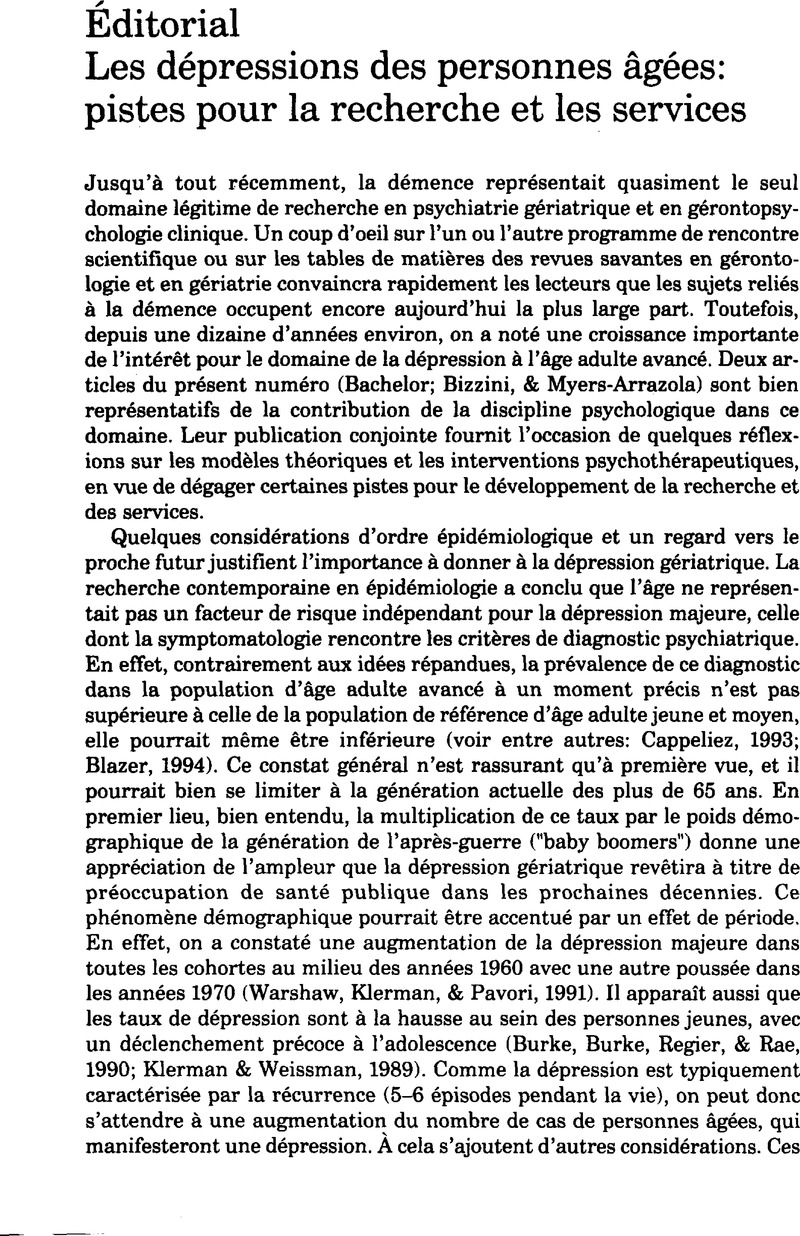No CrossRef data available.
Article contents
Éditorial Les dépressions des personnes âgées: pistes pour la recherche et les services
Published online by Cambridge University Press: 29 November 2010
Abstract
An abstract is not available for this content so a preview has been provided. As you have access to this content, a full PDF is available via the ‘Save PDF’ action button.

- Type
- Editorial/Éditorial
- Information
- Canadian Journal on Aging / La Revue canadienne du vieillissement , Volume 15 , Issue 2 , Été/Summer 1996 , pp. 172 - 177
- Copyright
- Copyright © Canadian Association on Gerontology 1996
References
Références
Adelman, R.C. (1995). The Alzheimerization of aging. The Gerontologist, 35, 526–532.CrossRefGoogle ScholarPubMed
Blazer, D.G. (1994). Epidemiology of late-life depression. Schneider, Dans L.S., Reynolds, C.F., Lebowitz, B.D., & Friedhoff, A.J. (Éds.), Diagnosis and treatment of depression in late life: Results of the NIH Consensus Development Conference (pp. 9–19). Washington, DC: American Psychiatric Press.Google Scholar
Burke, K.C., Burke, J.D., Regier, D.A., & Rae, D.S. (1990). Age at onset of selected mental disorders in five community populations. Archives of General Psychiatry, 47, 511–518.CrossRefGoogle ScholarPubMed
Cappeliez, P. (1993). Depression in elderly persons: Prevalence, predictors, and psychological intervention. Cappeliez, Dans P. & Flynn, R.J. (Éds.), Depression and the social environment: Research and intervention with neglected populations (pp. 332–368). Montréal: McGill-Queen's University Press.CrossRefGoogle Scholar
Cappeliez, P., & Flynn, R.J. (1993). An integrative cognitive-environmental view of depression. Cappeliez, Dans P. & Flynn, R.J. (Éds.), Depression and the social environment: Research and intervention with neglected populations (pp. 1–11). Montréal: McGill-Queen's University Press.CrossRefGoogle Scholar
Champion, L.A., & Power, M.J. (1995). Social and cognitive approaches to depression: Towards a new synthesis. British Journal of Clinical Psychology, 34, 485–503.CrossRefGoogle ScholarPubMed
Coyne, J.C., & Whiffen, V.E. (1995). Issues in personality as diathesis for depression: The case of sociotropy-dependency and autonomy-self-criticism. Psychological Bulletin, 118, 358–378.CrossRefGoogle ScholarPubMed
Estes, C.L., & Binney, F.A. (1989). The biomedicalization of aging: Dangers and dilemnas. The Gerontologist, 29, 587–596.CrossRefGoogle Scholar
Klerman, G.L., & Weissman, M.M. (1989). Increasing rates of depression. Journal of the American Medical Association, 261, 2229–2235.CrossRefGoogle ScholarPubMed
Long, C.G., & Hollin, C.R. (1995). Single case design: A critique of methodology and analysis of recent trends. Clinical Psychology and Psychotherapy, 2, 177–191.CrossRefGoogle Scholar
Lyddon, W.J. (1995). Cognitive therapy and theories of knowing: A social constructionist view. Journal of Counseling & Development, 73, 579–585.CrossRefGoogle Scholar
Mohide, E.A., & Streiner, D.L. (1993). Depression in caregivers of impaired elderly family members. Cappeliez, Dans P. & Flynn, R.J. (Éds.), Depression and the social environment: Research and intervention with neglected populations (pp. 289–331). Montréal: McGill-Queen's University Press.CrossRefGoogle Scholar
Mossey, J. (1993, novembre). Subsyndromal depression in the elderly: Epidemiologic al, clinical and treatment aspects. Symposium conduit à la 46e réunion scientifique annuelle de la Gerontological Society of America, New Orleans, LA.Google Scholar
Newmann, J.P. (1989). Aging and depression. Psychology and Aging, 4, 150–165.CrossRefGoogle ScholarPubMed
Niederehe, G.T. (1994). Psychosocial therapies with depressed older adults. Schneider, Dans L.S., Reynolds, C.F., Lebowitz, B.D., & Friedhoff, A.J. (Éds.), Diagnosis and treatment of depression in late life: Results of the NIH Consensus Development Conference (pp. 293–315). Washington, DC: American Psychiatric Press.Google Scholar
Redinbaugh, E.M., MacCallum, R.C., & Kiecolt-Glaser, J.K. (1995). Recurrent syndromal depression in caregivers. Psychology and Aging, 10, 358–368.CrossRefGoogle ScholarPubMed
Rice, D.P., & Miller, L.S. (1995). The economic burden of affective disorders. British Journal of Psychiatry, 166 (suppl. 27), 34–42.CrossRefGoogle Scholar
Scogin, F., & McElreath, L. (1994). Efficacy of psychosocial treatments for geriatric depression: A quantitative review. Journal of Consulting and Clinical Psychology, 62, 69–74.CrossRefGoogle ScholarPubMed
Warshaw, M.G., Klerman, G.L., & Pavori, P.W. (1991). The use of conditional probablities to examine age-period-cohort data: Further evidence for a period effect in major depressive disorder. Journal of Affective Disorders, 23, 119–129.CrossRefGoogle Scholar
Watt, L.M., & Cappeliez, P. (1995). Reminiscence interventions for the treatment of depression in older adults. Haight, Dans B.K. & Webster, J.D. (Éds.), The art and science of reminiscing: Theory, research, methods, and applications (pp. 221–232). Washington, DC: Taylor & Francis.Google Scholar
Zivian, M.T., Larsen, W., Gekoski, W., Knox, V.J., & Hatchette, V. (1994). Psychotherapy for the elderly: Public opinion. Psychotherapy, 31, 492–502.CrossRefGoogle Scholar
Zivian, M.T., Larsen, W., Knox, V.J., Gekoski, W.L., & Hatchette, V. (1992). Psychotherapy for the elderly: Psychotherapists' preferences. Psychotherapy, 29, 668–674.CrossRefGoogle Scholar


